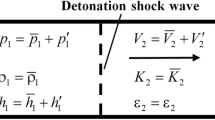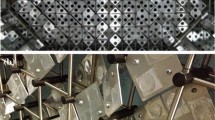Abstract
A single trailing vortex developed behind a micro-wing immersed in a free stream was used to study the vortex receptivity of the boundary layer on a flat plate. As a result of the interaction, in the boundary layer there develop longitudinal-velocity disturbances which grow almost linearly in the longitudinal coordinate. The parameters of the excited steady disturbances agree with the data of previous experiments performed under natural conditions and dealing with an “indirect” scenario of laminar-turbulent transition at high free-stream turbulence. It is shown that the leading edge of the plate does not play a decisive role in the mechanism of growth of disturbances of this kind and the receptivity is non-local in nature.
Similar content being viewed by others
REFERENCES
G. B. Schubauer and H. K. Skramsted, “Laminar-boundary-layer oscillations and transition on a flat plate,” NACA Report TN No. 909 (1948).
H. Bippes, “Basic experiments on transition in the three-dimensional boundary layers dominated by crossflow instability,” Progr. Aerospace Sci., 35, No. 4, 363 (1999).
V. V. Kozlov and O. S. Ryzhov, “Receptivity of boundary layers: asymptotic theory and experiment,” Proc. Roy. Soc. London, Ser. A, 429, No. 1877, 341 (1990).
J. M. Kendall, “Boundary layer receptivity to free-stream turbulence,” AIAA Paper, No. 90-1504 (1990), 7 p.
A. V. Boiko, K. J. A. Westin, B. G. B. Klingmann, et al., “Experiments in a boundary layer subjected to free-stream turbulence. Pt 2. The role of TS-waves in the transition process,” J. Fluid Mech., 281, 219 (1994).
P. H. Alfredsson, A. A. Bakchinov, V. V. Kozlov, and M. Matsubara, “Laminar-turbulent transition at a high level of a free-stream turbulence,” in: Nonlinear Instability and Transition in Three-Dimensional Boundary Layers, Kluwer, Dordrecht (1996), pp. 423-436.
L. S. Hultgren and L. H. Gustavsson, “Algebraic growth of disturbances in a laminar boundary layer,” Phys. Fluids, 24, No. 6, 1000 (1981).
P. S. Klebanoff, K. D. Tidtrom, and L. M. Sargent, “The three-dimensional nature of boundary-layer instability,” J. Fluid Mech., 12, Pt 1, 1 (1962).
K. J. A. Westin, A. V. Boiko, B.G. B. Klingmann, et al., “Experiments in a boundary layer subjected to free-stream turbulence, Pt 1. Boundary layer structure and receptivity,” J. Fluid Mech., 281, 193 1994.
V. S. Kosorygin, N. F. Polyakov, T. T. Suprun, and Épik, “Disturbance development in the boundary layer on a plate at high free-stream turbulence,” in: Sub-and supersonic flow instability (Ed. V.Ya Levchenko) [in Russian], Ins. Theoret. Appl. Mech. SB AS USSR, Novosibirsk (1982), pp. 85-92.
K. J. A. Westin, A. A. Bakchinov, V. V. Kozlov, and P. H. Alfredsson, “Experiments on localized disturbances in a flat plate boundary layer. Pt 1. The receptivity and evolution of a localized free-stream disturbance,” Eur. J. Mech., B/Fluids, 17, No. 6, 823 (1998).
F. P. Bertolotti, “Response of the Blasius boundary layer to free-stream vorticity,” 9, No. 8, 2286 (1997).
J. M. Kendall, “Studies on laminar boundary layer receptivity to free-stream turbulence near a leading edge,” in ASME Techn. Report FED. V. 114: Boundary Layer Stability and Transition to Turbulence (Ed. D.C. Reda et al.) (1991), pp. 23-30.
M. E. Goldstein, S. J. Leib, and S. J. Cowley, “Distortion of a flat plate boundary layer by free-stream vorticity normal to the plate,” J. Fluid Mech., 237, 231 (1992).
F. P. Bertolotti and J. M. Kendall, “Response of the Blasius boundary layer to controlled free-stream vortices of axial form,” AIAA Paper, No. 97-2018 (1997).
W. W. Willmarth and T. J. Bogar, “Survey and new measurements of turbulent structures near wall,” Phys. Fluids, 20, No. 10, S9 (1977).
H. Bippes, “Experimente zur Entwicklung der freienWirbel hinter einem RechteckflÜgel,” Acta Mech., 26, No. 1-4, 223 (1977).
G. K. Batchelor, “Axial flow in trailing line vortices,” J. Fluid Mech., 20, 645 (1964).
B.G.B. Klingmann, A. V. Boiko, K.J.A. Westin, et al., “Experiments on the stability of Tollmien-Schlichting waves,” Eur. J. Mech., B/Fluids, 12, No. 4, 493 (1993).
M. Matsubara, A. A. Bakchinov, J.H.M. Fransson, and P. H. Alfredsson, “Growth and breakdown of streaky structures in boundary layer transition induced by free-stream turbulence,” in: Laminar-Turbulent Transition: IUTAM Symp. (Ed. H.P. Fasel and W.S. Saric), Springer, Sedona (1990), pp. 371-376.
P. Luchini, “Reynolds-number-independent instability of the boundary layer over a flat surface: optimal perturbations,” J. Fluid Mech., 404, 289 (2000).
S. Berlin and D. S. Henningson. “A nonlinear mechanism for receptivity of free-stream disturbances,” Phys. Fluids, 11, No. 12, 3749 (1999).
J. M. Kendall, “Experimental study of disturbances produced in a pre-transitional laminar boundary layer by weak free-stream turbulence,” AIAA Paper, No. 85-1695 (1985).
P. A. Libly and H. Fox, “Some perturbation solutions in laminar boundary-layer theory,” J. Fluid Mech., 17, 433 (1964).
Rights and permissions
About this article
Cite this article
Boiko, A.V. Flat-Plate Boundary Layer Receptivity to a Steady Free-Stream Vortex Disturbance. Fluid Dynamics 36, 915–925 (2001). https://doi.org/10.1023/A:1017962626180
Issue Date:
DOI: https://doi.org/10.1023/A:1017962626180




